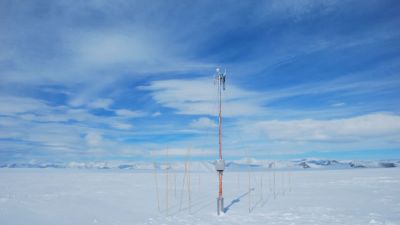
Research at Princess Elisabeth Station: HYDRANT
HYDRANT (HYDRologic system of ANTarctica) is a project designed by Prof. Nicole van Lipzig from the Katholieke Universiteit Leuven (KUL) which aims to investigate the atmospheric part of the Antarctic hydrologic cycle from moisture evaporation and cloud formation to snowfall. Dr. Irina Gorodetskaya is HYDRANT's project main scientist, and is in charge of setting up instruments to be used for the project at the Princess Elisabeth Station.
HYDRANT Objectives
The ice that makes up the vast Antarctic ice sheet comes entirely from accumulated snowfall. However, the distribution of snowfall over the Earth's southernmost continent is widely uneven. The coast receives a lot of snow, whereas the interior of the continent gets about as much precipitation as the Sahara Desert. However, snowfall in the continent's interior stays there for millennia and increases the ice sheet's overall mass balance while the ice sheet loses mass near its edges along the coasts. Each year along the coasts, most of the freshly-fallen snow either sublimes (a direct transition from snow to water vapour), is carried away by the katabatic winds (strong winds carrying high density air from the higher elevations of the interior of the ice sheet down towards the coast under the force of gravity), or simply melts. Ice that forms in the interior of the ice sheet also gets discharged into the sea at the coast.
By investigating all the components of the Antarctic hydrologic cycle, including the continent's cloud formation, it is possible to understand the mechanisms that determine Antarctica's surface mass balance, making it possible to predict changes in the ice sheet's mass balance and how much loss of ice will contribute to sea level rise over the next coming centuries.
This study's focus on clouds is significant: not only do they influence precipitation at the surface of the Earth; they also trap thermal radiation within the Earth's atmosphere and send it back to the surface, heating it up.
At present, hydrologic processes in Antarctica are still poorly understood, one of the reasons being the lack of field observations. The Princess Elisabeth Station is located at a key area between the coast and the high plateau-an area influenced by cyclones that bring in heat and moisture from the warmer regions surrounding Antarctica and cold katabatic winds from the interior of the Antarctic Ice Sheet. The first data for this study were collected during the BELARE 2008-2009 field campaign.
BELARE 2008-2009 Field Campaign
Instruments set up in February 2009:
- The Automatic Weather Station (AWS) records temperature, pressure, wind, radiation, snow height changes, and the snow's temperature profile. Data are recorded locally and sent to Europe automatically via an ARGOS satellite antenna. The AWS was developed at the Institute for Marine and Atmospheric Research at Utrecht University (IMAU), one of the institutions collaborating in the HYDRANT project.
- The ceilometer uses a laser to measure the cloud base height.
- The infra-red radiation pyrometer measures the cloud base temperature when clouds are present.
The latter two cloud instruments were temporarily set up on the roof of one of the shelters that house scientific equipment. Even though the cloud measurement period was short (February 6-22), it was a chance to take some initial measurements in changing weather conditions. The data collected provided valuable information on cloud properties, snowfall and wind-blown snow at the end of the summer season. More details on the last year measurements can be found on the HYDRANT project website
BELARE 2009-2010 Field Campaign
During this year's BELARE expedition, a new ARGOS satellite antenna will be installed at the AWS, allowing data to be sent to Europe in real time. Another device will also be added so the Princess Elisabeth Station can receive the data as well, making it possible to receive immediate weather updates. Data collected from the weather station is to be used for climate research.
Furthermore, the HYDRANT project will focus on making continuous observations of meteorological and cloud conditions in order to validate regional climate models. In order to make this possible, all instruments for over-wintering operations must be set up. The KUL team will also bring a new radar instrument to measure precipitation to help determine the percentage of snowfall as opposed to wind-blown snow.
Picture: International Polar Foundation - © International Polar Foundation
